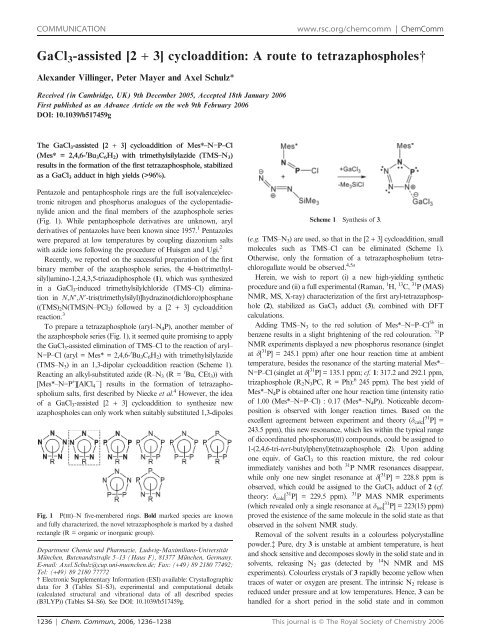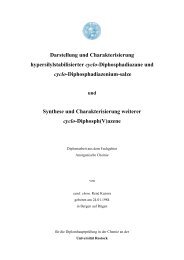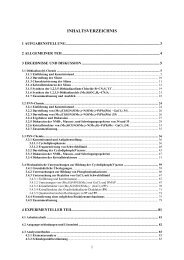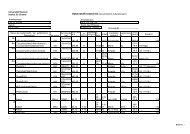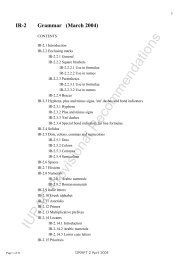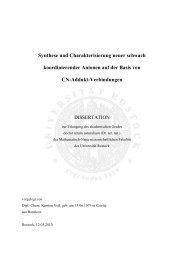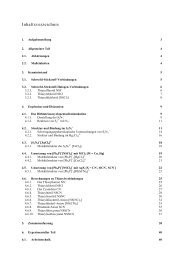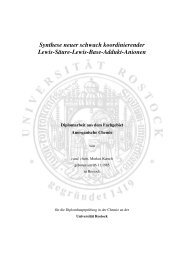Darstellung und Charakterisierung neuer niedrigkoordinierter ...
Darstellung und Charakterisierung neuer niedrigkoordinierter ...
Darstellung und Charakterisierung neuer niedrigkoordinierter ...
Create successful ePaper yourself
Turn your PDF publications into a flip-book with our unique Google optimized e-Paper software.
COMMUNICATION www.rsc.org/chemcomm | ChemComm<br />
GaCl 3-assisted [2 + 3] cycloaddition: A route to tetrazaphospholes{<br />
Alexander Villinger, Peter Mayer and Axel Schulz*<br />
Received (in Cambridge, UK) 9th December 2005, Accepted 18th January 2006<br />
First published as an Advance Article on the web 9th February 2006<br />
DOI: 10.1039/b517459g<br />
The GaCl3-assisted [2 + 3] cycloaddition of Mes*–NLP–Cl<br />
(Mes* = 2,4,6- t Bu3C6H2) with trimethylsilylazide (TMS–N3)<br />
results in the formation of the first tetrazaphosphole, stabilized<br />
as a GaCl3 adduct in high yields (>96%).<br />
Pentazole and pentaphosphole rings are the full iso(valence)electronic<br />
nitrogen and phosphorus analogues of the cyclopentadienylide<br />
anion and the final members of the azaphosphole series<br />
(Fig. 1). While pentaphosphole derivatives are unknown, aryl<br />
derivatives of pentazoles have been known since 1957. 1 Pentazoles<br />
were prepared at low temperatures by coupling diazonium salts<br />
with azide ions following the procedure of Huisgen and Ugi. 2<br />
Recently, we reported on the successful preparation of the first<br />
binary member of the azaphosphole series, the 4-bis(trimethylsilyl)amino-1,2,4,3,5-triazadiphosphole<br />
(1), which was synthesized<br />
in a GaCl3-induced trimethylsilylchloride (TMS–Cl) elimination<br />
in N,N9,N9-tris(trimethylsilyl)]hydrazino(dichloro)phosphane<br />
((TMS)2N(TMS)N–PCl2) followed by a [2 + 3] cycloaddition<br />
reaction. 3<br />
To prepare a tetrazaphosphole (aryl–N4P), another member of<br />
the azaphosphole series (Fig. 1), it seemed quite promising to apply<br />
the GaCl3-assisted elimination of TMS–Cl to the reaction of aryl–<br />
NLP–Cl (aryl = Mes* = 2,4,6- t Bu 3C 6H 2) with trimethylsilylazide<br />
(TMS–N3) in an 1,3-dipolar cycloaddition reaction (Scheme 1).<br />
Reacting an alkyl-substituted azide (R–N3 (R = t Bu, CEt3)) with<br />
[Mes*–NLP + ][AlCl 4 2 ] results in the formation of tetrazaphospholium<br />
salts, first described by Niecke et al. 4 However, the idea<br />
of a GaCl 3-assisted [2 + 3] cycloaddition to synthesize new<br />
azaphospholes can only work when suitably substituted 1,3-dipoles<br />
Fig. 1 P(III)–N five-membered rings. Bold marked species are known<br />
and fully characterized, the novel tetrazaphosphole is marked by a dashed<br />
rectangle (R = organic or inorganic group).<br />
Department Chemie <strong>und</strong> Pharmazie, Ludwig-Maximilians-Universität<br />
München, Butenandtstraße 5–13 (Haus F), 81377 München, Germany.<br />
E-mail: Axel.Schulz@cup.uni-muenchen.de; Fax: (+49) 89 2180 77492;<br />
Tel: (+49) 89 2180 77772<br />
{ Electronic Supplementary Information (ESI) available: Crystallographic<br />
data for 3 (Tables S1–S3), experimental and computational details<br />
(calculated structural and vibrational data of all described species<br />
(B3LYP)) (Tables S4–S6). See DOI: 10.1039/b517459g.<br />
Scheme 1 Synthesis of 3.<br />
(e.g. TMS–N3) areused,sothatinthe[2+ 3] cycloaddition, small<br />
molecules such as TMS–Cl can be eliminated (Scheme 1).<br />
Otherwise, only the formation of a tetrazaphospholium tetrachlorogallate<br />
would be observed. 4,5a<br />
Herein, we wish to report (i) a new high-yielding synthetic<br />
procedure and (ii) a full experimental (Raman, 1 H, 13 C, 31 P(MAS)<br />
NMR, MS, X-ray) characterization of the first aryl-tetrazaphosphole<br />
(2), stabilized as GaCl3 adduct (3), combined with DFT<br />
calculations.<br />
Adding TMS–N3 to the red solution of Mes*–NLP–Cl 5b in<br />
benzene results in a slight brightening of the red colouration. 31 P<br />
NMR experiments displayed a new phosphorus resonance (singlet<br />
at d[ 31 P] = 245.1 ppm) after one hour reaction time at ambient<br />
temperature, besides the resonance of the starting material Mes*–<br />
NLP–Cl (singlet at d[ 31 P] = 135.1 ppm; cf. 1: 317.2 and 292.1 ppm,<br />
trizaphosphole (R 2N 3PC, R = Ph): 6 245 ppm). The best yield of<br />
Mes*–N4P is obtained after one hour reaction time (intensity ratio<br />
of 1.00 (Mes*–NLP–Cl) : 0.17 (Mes*–N4P)). Noticeable decomposition<br />
is observed with longer reaction times. Based on the<br />
excellent agreement between experiment and theory (dcalc[ 31 P] =<br />
243.5 ppm), this new resonance, which lies within the typical range<br />
of dicoordinated phosphorus(III) compo<strong>und</strong>s, could be assigned to<br />
1-(2,4,6-tri-tert-butylphenyl)tetrazaphosphole (2). Upon adding<br />
one equiv. of GaCl3 to this reaction mixture, the red colour<br />
immediately vanishes and both 31 P NMR resonances disappear,<br />
while only one new singlet resonance at d[ 31 P] = 228.8 ppm is<br />
observed,whichcouldbeassignedtotheGaCl3 adduct of 2 (cf.<br />
theory: d calc[ 31 P] = 229.5 ppm). 31 P MAS NMR experiments<br />
(which revealed only a single resonance at diso[ 31 P] = 223(15) ppm)<br />
provedtheexistenceofthesamemoleculeinthesolidstateasthat<br />
observed in the solvent NMR study.<br />
Removal of the solvent results in a colourless polycrystalline<br />
powder.{ Pure, dry 3 is unstable at ambient temperature, is heat<br />
and shock sensitive and decomposes slowly in the solid state and in<br />
solvents, releasing N 2 gas (detected by 14 N NMR and MS<br />
experiments). Colourless crystals of 3 rapidly become yellow when<br />
traces of water or oxygen are present. The intrinsic N2 release is<br />
reduced <strong>und</strong>er pressure and at low temperatures. Hence, 3 can be<br />
handled for a short period in the solid state and in common<br />
1236 | Chem. Commun., 2006, 1236–1238 This journal isßThe Royal Society of Chemistry 2006


